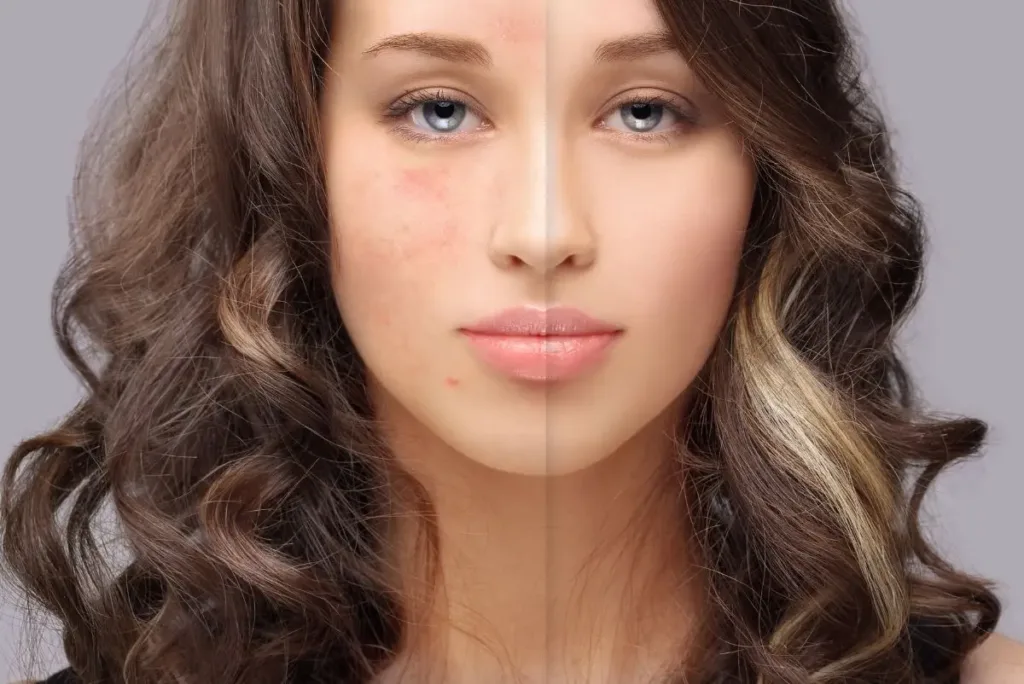Have you ever wondered why some acne just won’t go away, no matter what you do? You’re not alone. A lot of people struggle with a stubborn type of acne that’s not your typical acne, it’s called fungal acne.
Unlike regular acne, which is caused by bacteria, fungal acne is caused by an overgrowth of yeast, a type of fungus, on your skin. It’s sneaky, frustrating, and often keeps coming back, leaving many of us wondering, why does my fungal acne keep coming back?
In this article, I will explain why it’s different from other acne and, more importantly, why it keeps coming back.

Why Does My Fungal Acne Keep Coming Back
1. It is different from bacterial acne
Fungal acne, it’s a tricky thing. You see, it’s not like the usual acne most of us know about. Regular acne, the kind that teenagers often get, is caused by bacteria. But fungal acne? That’s a whole different story.
It’s caused by yeast, which is a type of fungus. This yeast lives on everyone’s skin, but sometimes it grows too much and causes problems. The little red bumps from fungal acne might look like regular acne, but they’re not the same.
2. Misdiagnosis challenges
Because fungal acne looks a lot like bacterial acne, it’s often misdiagnosed. This means that many people with fungal acne spend a lot of time trying treatments for bacterial acne which don’t work for them.
3. Inappropriate treatments
When fungal acne is mistaken for bacterial acne, the treatments used can sometimes make things worse. Many over-the-counter acne products are meant for bacterial acne and contain ingredients like benzoyl peroxide or salicylic acid.
These products might help with regular pimples, but they don’t do much for fungal acne. In fact, they can sometimes feed the yeast or irritate your skin, making the fungal acne stick around even longer.
Causes of Fungal Acne Recurrence
Fungal acne has a way of coming back, often when you least expect it. Let’s break down why this happens.
1. Excessive sweating
Sweat can be a big part of why fungal acne keeps coming back. Yeast loves moist environments. When you sweat a lot, especially if you stay in your workout clothes, you’re creating the perfect home for yeast to grow.
2. Humid environments
Just like sweat, living in a place that’s hot and humid can also be a problem. High humidity means there’s a lot of moisture in the air, and this moisture can settle on your skin. Yeast thrives in that.
3. Oily skin
Our skin naturally makes oil, which is normally a good thing. But, if your skin is extra oily, it can be a problem for fungal acne. The oil can mix with dead skin cells and clog your pores. This creates a feast for yeast, making it grow and cause acne.
4. Immune system issues
Sometimes, our body’s defense system, the immune system, might not be as strong as it needs to be. This can happen for various reasons, like stress or illness. When our immune system isn’t at its best, it’s harder to fight off the yeast, leading to more outbreaks of fungal acne.
5. Incomplete treatment courses
If you stop your antifungal treatment too soon, even if your skin looks better, the yeast might not be completely gone. This can lead to a comeback.
6. Inadequate antifungal agents
Not all treatments are created equal. Some antifungal products might not be strong enough to fully tackle the yeast.
7. Resistance to antifungal treatment
Using antifungal treatments too often or in the wrong way can make the yeast get used to them. The yeast can become resistant, making it harder to treat the acne.
8. Underlying health conditions
Certain health conditions like diabetes or hormonal imbalances can make you more prone to fungal acne. These conditions can affect your skin’s environment, making it easier for yeast to grow.

How to Prevent and Manage Recurring Fungal Acne
Dealing with recurring fungal acne can be a challenge, but with the right steps, you can keep those pesky bumps at bay. Here’s how:
1. Stay dry and clean
Remember how yeast loves moisture? Keeping your skin dry and clean is key. After exercising or sweating, make sure to shower and change into dry clothes.
2. Choose your clothes wisely
Wear loose, breathable clothing, especially in hot and humid weather. Tight clothes can trap sweat and create a playground for yeast. So, opt for fabrics that let your skin breathe.
3. Skin care routine adjustments
If you have oily skin, using products that control oil without drying out your skin is important. Look for non-comedogenic products that won’t clog pores. It’s all about balance – keeping the skin clean but not too dry.
4. Boost your immune system
A strong immune system can help keep fungal acne in check. Eat a balanced diet, get enough sleep, and manage stress. Think of your immune system as your body’s security guard against yeast overgrowth.
5. Complete your treatment course
If your doctor prescribes an antifungal treatment, make sure to finish the entire course, even if your skin starts looking better. Stopping treatment early is like leaving the door slightly open for yeast to come back.
6. Use the right products
Not all antifungal products are the same. Make sure you’re using a product that’s effective against the yeast causing your acne.
7. Be mindful of antifungal use
Using antifungals correctly is crucial. Overusing them or using them incorrectly can lead to resistance, making them less effective. Follow your doctor’s advice in the letter.
8. Manage underlying conditions
If you have a health condition like diabetes or a hormonal imbalance, managing it can help control fungal acne. It’s about treating not just the skin but also your overall health.
9. Regular skin checks
Keep an eye on your skin. If you notice the early signs of fungal acne, act quickly. Early intervention can prevent a full-blown outbreak.
Fungal Acne Diet – What Food Fights Fungal Acne Infection?
While there are many suggested solutions for fungal acne, there are ways you can manage it with diet and lifestyle changes. Here are some foods that fight fungal acne infection:
1. Coconut oil
Coconut oil is a great food for fighting fungal acne infections.
Coconut oil helps your body fight off the fungus that causes acne by destroying the cell membranes of the fungi.
It also has anti-fungal properties and can help reduce inflammation in the skin. In addition, coconut oil contains lauric acid, which helps boost your immune system and fight invaders like bacteria and viruses.
2. Turmeric
Turmeric is one of the secret ingredients that fight fungal acne infection.
It has been used in cooking since ancient times and has many health benefits. It is also known to have anti-inflammatory properties, which makes it a powerful tool against fungal acne infection.
Turmeric contains curcumin, an active compound that has been proven to fight fungal infections.
3. Garlic
Garlic is a great food to fight fungal acne infection. It has the ability to fight against fungus and can also reduce inflammation, which is especially useful if you develop pustules or cysts on your skin.
Garlic’s anti-fungal properties make it an excellent addition to your diet if you suffer from fungal acne.
4. Ginger
Ginger is a great food to eat if you’re trying to fight fungal acne. It’s anti-inflammatory, anti-bacterial, and anti-fungal.
Ginger contains two compounds that fight fungi: gingerol and zingerone. These compounds help cleanse your body of toxins and prevent fungus from forming on your skin.
Ginger also has anti-inflammatory properties, which can help relieve inflammation caused by fungal acne infections.
5. Kale
Kale is a leafy green vegetable that comes in wide varieties. It’s known for its high amount of vitamins, minerals, and fiber, but it also contains antifungal properties.
It’s one of the best foods to eat when you have fungal acne as it can help to reduce inflammation and fight off infections.
Kale is a great food for fighting fungal acne and preventing future outbreaks. It contains sulfur, which is a key component in helping to fight off and prevent fungal infections.
Conclusion
There are a variety of reasons why fungal acne keeps making an unwanted comeback. It might be due to factors like excessive moisture from sweat, humid environments, the nature of your skin, or even underlying health issues.
But the good news is that by understanding these triggers and implementing the right skincare routines, lifestyle changes, and treatment plans, you can take effective steps to keep fungal acne at bay.
Managing fungal acne is a journey that involves both care and persistence. With the right approach, you can keep your skin healthy and clear and say a firm goodbye to recurring fungal acne.
Sources:
https://my.clevelandclinic.org/health/diseases/24341-fungal-acne






